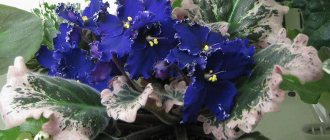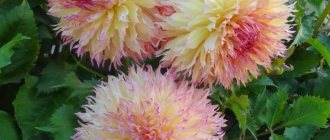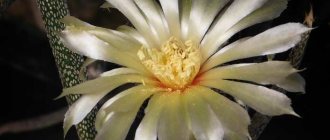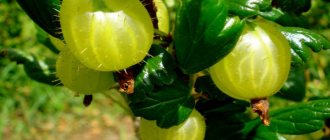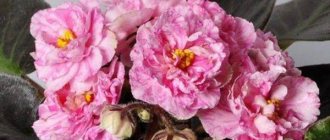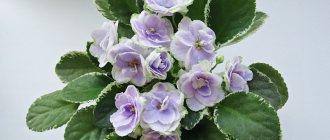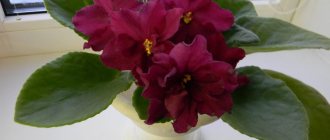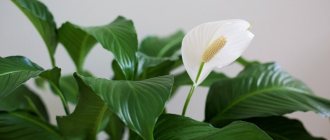Violet is a houseplant that almost no one knew about 50 years ago. Today, in the course of breeding work, numerous varieties of this amazing ornamental crop have been introduced. Among all the variety of violets, gardeners distinguish the “Black Pearl” variety. It is distinguished by its incredible beauty of flowering and easy care.
Dear readers! For you, we have created communities on social networks in which useful articles and interesting ideas are published several times a day! Subscribe and receive useful content in a convenient format!
Description
Black Pearl is a variety of violets that is perfect for experienced gardeners or hobbyists. It is distinguished by long and bright flowering , which once you see, you will not remain indifferent.
History of the variety, who bred it
This variety of violet was bred by the famous breeder E. Korshunov.
Leaves
The leaves of the plant are dark green, both on the outside and on the inside. Their surface is velvety.
Flowers
Violet flowers are simply impressive in their size, as the diameter is 7 cm.
But during flowering, the flowers gather in inflorescences-a cap, as a result of which it is simply impossible to take your eyes off the plant.
Features and differences from other varieties
The “Black Pearl” violet differs from other species in that it has large double flowers. They have a purple color with a noble velvet tint. In addition, the flowering of the plant can be extended if you follow all the rules of agricultural technology.
Photos and detailed description of the variety
The Black Pearl variety can be safely attributed to the “golden fund” of violets by breeder Elena Korshunova. Large double flowers of purple-violet color impress all violet lovers. But the photo and description cannot fully convey the special velvety tint of a dark shade on the petals of this violet. It gives a special charm to a plant with a classic color.
The peduncles of the variety form an inflorescence-cap consisting of 6-8 corollas. The diameter of each flower is 6.5-7 centimeters. The buds open slowly, turning into a thick pompom. With proper care, violets can bloom almost constantly.
[adsp-pro-4]
The rosette of the variety is smooth, large in size (diameter 35-40 centimeters). The leaves of the variety are oblong with a rounded end. The edges of the sheet are smooth, the entire plate is slightly wavy. The leaf color is dark green. The surface is slightly velvety, with small fibers.
Violet Black Pearl sometimes forms sports, one of which, Gray Ocean, is officially registered. The rosette of the sport is light, the flowers are lilac.
Photo of violet EK “Black Pearl”
Common mistakes
It’s not in vain that we spend so much time on the issue of watering. It is because of mistakes associated with waterlogging or drying out the soil that many of you are deprived of such a miracle as the “black pearl” violet. The description of the variety (the photo clearly shows us its beauty) suggests that any deviation adversely affects the health of the plant. Watering can only be done with warm, well-settled water. Make sure that it does not get on the leaves, so the preference is still to water through a tray. Spraying from a spray bottle is also a bad option, since the liquid gets into the sockets.
Growing conditions
The growing conditions for this variety are listed below.
Priming
The plant variety in question is popular because, if you follow simple care rules, the plant can delight others with its flowering throughout the year. It is very important to choose the right soil mixture. Use light and loose soil. This will saturate the root system with oxygen. At the same time, the soil must retain moisture well.
Attention! If you do not want to buy ready-made substrate in a specialized store, then you can prepare it yourself. To do this, take components such as peat, leaf, turf and coniferous soil. Dilute the resulting mixture with river sand.
Pot
It is necessary to grow the “Black Pearl” violet in pots whose height and diameter are 10 cm.
Moreover, ½ of the lower part should consist of drainage. Until the roots fill the container with soil, the violet will not bloom.
For breeding, the first pot can be 6 cm in diameter. In this case, the drainage hole should be large.
Lighting
In order for the violet to fully grow and develop, it is necessary to provide it with adequate lighting. To do this, keep pots with plants on the windowsill. Just make sure that direct sunlight does not penetrate it.
Temperature
To grow this variety of indoor plant, it is necessary to maintain a temperature regime of 20-24 degrees. If the temperature is 20 degrees, then adult specimens will bloom for a long time, and the flowers themselves will be large. For young plants that have just been separated from the mother leaf, it is worth setting the temperature regime to 23-24 degrees.
Humidity
Suitable humidity for violets remains 60-70%. If you exceed this figure, the crop may get sick and die
Groups of violets
Collectible
Collections are different. Some people collect new types of Saintpaulias, others collect rare specimens, others collect fantasy ones, others collect miniatures, and so on. Collections are often presented at exhibitions.
Variegated
Variegated violets create a festive, elegant atmosphere, even when they are not blooming. Such Saintpaulias are an excellent decor for an apartment.
Important! Grows best in a cool room with good
lighting
They are divided into 5 types:
- Tommy Lowe variegation - green leaves edged in white, pink or beige. The sheet may have inclusions of the same color;
- Mosaic variegation (Lilian Jarrett) is less common than others. The variegated fragments are located evenly over the entire surface of the leaf. Such Saintpaulias grow more slowly;
- Crown variegation (Champion) - yellow, light green, pink, cream color in the form of a variegated pattern is placed on green young leaves. After the plant blooms, the leaves may turn green. After a few months, with new leaves, the pattern returns;
- Spontaneous variegation is a mutation that can appear in the form of a variegated pattern on a single leaf or on the entire Saintpaulia. It may remain or disappear after a while;
- Leaf chimeras are valued most for the unique pattern that is formed due to mutation. The pattern is large and repeated on all leaves. They are rare.
Industrial
Industrial violets are grown in greenhouses, in large quantities, on stream. In order for the plant to grow faster and bloom profusely, it is stuffed with growth and flowering stimulants, various fertilizers and additives to give it a “marketable” appearance.
Interesting! In European countries, such Saintpaulias are given instead of a bouquet of cut flowers. And after they fade, they are thrown away. In order to make such a violet at home, knowledge and experience are required.
Industrial violets have their advantages:
- they bloom in a cap and look like a bouquet;
- unpretentious in care;
- have a symmetrical rosette and strong peduncles;
- they are characterized by bouquet flowering;
- reproduce well and transmit varietal characteristics;
- they can be used to decorate holiday tables;
- they can be planted in a group with other plants.
Planting and propagation
The Black Pearl violet reproduces by leaf.
To do this, you need to cut the leaf stalk with a sharp knife at a sharp angle. The length of the cutting is 3 cm. Water can be used to root the leaf. Pour it into a plastic or glass container, place ½ tablet of activated carbon there, and then install a leaf.
When the length of the root system is 1.5-2 cm, plant the leaf in peat, deepening it by 1 cm with an inclination of 45 degrees. Water thoroughly, cover with polyethylene and place in a bright and warm place.
Rooting of the leaf occurs within 2-4 weeks. Babies are formed in 1.5-2 months. All this time the leaf should be under polyethylene. Perform airing once a week, opening the film for 1-2 minutes. As soon as 2-3 pairs of leaves are formed on the children, then plant each one in separate containers, the diameter of which is 6-7 cm.
Articles about other varieties of violets: “Southern Night”, “Sea Wolf”, “Chateau Brion”, “Dance of the Galaxies”, “Goddess of Beauty”, “Angelique”, “LE Isadora”, “Duchess”, “Winter Smiles” and others.
Violets from breeders of the CIS countries - “F”
Unusual double flowers with cupped petals, ash-pink flowers with a silver coating on the outside and brownish-green on the inside. The inner surface of the flower has a pronounced venous pattern. A variety with a twist, for lovers of evergreens.
Medium green leaves. Standard. Smooth, compact self-forming rosette of medium size. There just aren't many leaves on it.
As the flowers grow and bloom, the bouquet shimmers with all sorts of shades of pink, pink-ash, cream, brownish coffee and even crimson, framed by a wide greenish-brown border. The green border is more pronounced in cool conditions. Flowers with a crimson tint began to appear after hot days. Each peduncle gives out its own coloring of the petals and the result is a multi-colored bouquet. Flowers - pearls, similar to hop cones, do not fully bloom.
Very long, almost continuous flowering in clusters even at high temperatures. Flowering can last for 5-6 months. There are always half-opened flowers on the rosette. The flowers are not large, but there are a large number of them and over time they become more and more numerous, as new flower stalks grow, and the previously appeared ones continue to remain on the rosette. Infinite variety during the entire flowering period, which can continue until the flower stalks are removed. The buds open very slowly, remaining round beads of various shades of pink and ash color.
There are a lot of peduncles, up to 18 pieces, in each leaf axil. The peduncles are branched, each with 7 to 10 brown buds; in insufficient light they become long and, under the weight of the buds, fall on the leaves of the rosette. Even after cutting off the flower stalks and placing the bouquet in a vase, the flowers do not wither for 2 weeks.
It propagates well by cuttings, babies appear quite quickly. Grows quickly and blooms early. The downside of the variety is that it does not want to grow foliage at all, it is always in buds. It grows well on a wick in daylight, on a shelf where there was not enough light, the leaves of the rosette stretched out, and the first peduncles were so long that they hung from the rosette along with the ball flowers. In the sun you can get burns on some leaves. The sport is white with a green border, a simple pink color and fully bloomed regular semi-double flowers.
Similar Saintpaulias are TV-Wild Plum, TV-Paradise Apples, TV-Miracle Apples, TV-Pink Pearl. In the presented line of these varieties of violets, the father is all Reflections of Spring (LLG/P.Sorano), and the mother is different for everyone, with a star flower. The result is varieties that can easily tolerate heat, which is rare in modern violet varieties.
“The Jewel of the Nile” - The premiere of the film “Romancing the Stone” took place on March 30, 1984, and the following year the sequel, “The Pearl of the Nile,” was released.
Care
Care includes simple procedures listed below.
Watering
And although this plant variety responds positively to watering, you should not be too zealous.
Irrigate plants only with warm and settled water. When watering, do not allow water to get on the leaves, so it is best to water through a tray.
Spraying with a spray bottle is another great way to humidify as it will force water into the outlets.
Transfer
If the violet has stopped growing, then it is necessary to prepare a new pot, the diameter of which will be equal to 1/3 of the diameter of the rosette. The substrate also needs to be replaced. Since the root system of the plant is poorly developed, it should be replanted together with a lump of earth. Transfer the flower to a new pot and add substrate. All that remains is to water.
Fertilizer and feeding
The Black Pearl variety is sensitive to the composition of the soil.
If you do not fertilize, the plant will develop greenery and stop blooming. To saturate the soil with necessary microelements and substances, it is necessary to apply fertilizer once every 2 weeks.
Make sure that the concentration of the solution does not exceed 2 g per 1 liter of water. To protect the plant from fungal infection, treat the soil with a weak solution of potassium permanganate.
Diseases and parasites
The “Black Pearl” violet is extremely rarely affected by parasites and diseases. This occurs mainly due to non-compliance with the rules of agricultural technology.
Table 1 - Flower diseases and treatment methods
| Disease | Symptoms | Causes | Treatment and prevention |
| Powdery mildew | It damages leaves, petioles and peduncles in the form of a whitish coating. | Poor lighting, low temperature, high humidity, lack of potassium, nitrogen. | Treatment with Fundazol or Bentlan. In case of massive damage, treat the plant every 10 days. |
| Late blight | Root collar rotting, brown spots on leaves. | Inadequate care. | Remove affected plants, sterilize the hills, and treat the soil with superphosphate. |
| Gray rot | Fluffy brown-gray coating on leaves, stems and flowers. | Drafts, sudden changes in temperature, waterlogging of the soil. | Remove the affected parts of the plant and treat the crop with a fungicide. |
| Fusarium | The petioles of the leaves are affected by a brown coating, the leaves fall off, and the root system darkens. | Excessive waterlogging, temperature changes, use of cold water for irrigation. | Remove the affected parts and treat the crop with a fungicide. |
| Rust | Yellow-orange tubercles on the outside of the leaves. | Temperature changes, excessive watering, drafts. | Treatment with 1% Bordeaux mixture or fungicide solution. |
Table 2 - Violet pests and their control
| Pest | How to recognize | Fighting methods |
| Mite | The leaves are covered with depressed brown spots. | Treatment with Akarin, Actellik or Fitoverm. |
| Shchitovka | Affects rosettes with smooth leaves. Forms a sticky coating. | Treatment with Agravertine. |
| Thrips | They violate the integrity of the stamens, forming silvery nibbles on the flowers and brown spots on the leaves. | Remove affected plants along with the soil. |
| Aphid | It feeds on the sap of the plant, forming a sticky liquid on the leaves and peduncles. | Perform 2-3 treatments with Actellik (1 ml of product per 1 liter of water). |
| Woodlice | They damage the roots and leaves of violets, causing secondary infections. | The plant is sprayed and the soil is watered with Actellik or Fitoverma solution. |
brief information
Now let's move on to how to handle this plant. This is where many people have difficulties. Unlike an ordinary violet, which grows in any soil, you will have to work hard to form a beautiful bush that will delight you with luxurious flowers. So, what is a black pearl violet? Photos and descriptions will give you a complete picture. This is a herbaceous perennial plant with an underdeveloped fibrous root system. That is why it is recommended to choose shallow containers for planting.
The fleshy leaves of this species form a rosette, the diameter of which reaches 60 cm. The leaf blade is oblong in shape with a rounded tip. The edges are devoid of relief, and the leaf itself is slightly wavy. The color is rich, dark green, perfectly complements the purple hue of the flowers.
Violets on the windowsill - signs
Violets on the windowsill ruin your privacy
The enormous popularity of Saintpaulia has become the reason for many superstitions and signs with which this flower is associated. They say, for example, that the violet is a muzhegon, that is, an unmarried woman who grows indoor violets supposedly has no chance of getting married, and a married Saintpaulia lover has the risk of being left without a husband. But if you think carefully, it turns out that among your friends there are married women who have been growing violets for years. And even those of your friends who got married not so long ago can confidently find a violet or two on the windowsill. If you look.
Another superstition states that the indoor violet is an energy vampire and that you should not keep it in your bedroom because it causes drowsiness and loss of energy. But, if you look at it, violets, like any other plants, produce oxygen during the day, in the light, and at night, on the contrary, they absorb it and release carbon dioxide. And the lack of oxygen makes you sleepy. Hence the conclusion: there is no need to arrange a whole greenhouse on the windowsill in the bedroom.
Violets are good omens
But astrologers believe that violet, combining the energy of Taurus and the Moon, has a calming effect on a person, bringing comfort and good mood to the house. And like all flowers belonging to the sign of Taurus, they have the power of a talisman, guaranteeing security, stability, harmony and endowing a person with wisdom, endurance and inspiration in creativity. Like this…
Good luck to you!!!
Well, almost black violet Dark Night of The Soul
Speaking of almost black varieties, Dark Night of The Soul cannot be ignored.
A beautiful, uniform, symmetrical, semi-miniature rosette that molds itself. The leaves are variegated, rounded, and quite large. The peculiarity of the variety is that the leaves are spoon-shaped, the edges are slightly curled upward. The color of the leaves is variegated, medium green with white.
The flowers are wine-black, terry overalls with a coral-red reverse. On the bud, the half-open flower is almost black and as it opens it acquires a red tint, more like a beetroot.
Important! This is the only variety Macdonald developed outside of the Mac series.
Pests and diseases
Orchids need fresh air; care must be taken to ensure that the room in which they are located has minimal daily ventilation, but is not exposed to cold winter air.
Affected leaves
Air renewal is necessary in order to avoid the appearance of certain types of diseases, mainly caused by fungi.
Attention! High concentrations of moisture combined with high temperatures and polluted air provide ideal soil for the proliferation of fungi, bacteria and viruses. The most common pests are snails and slugs, especially if orchids are in the garden. If any symptoms of diseases are noticeable, it is recommended to contact a specialist garden center, where experts in the field can help and recommend remedies.
If any symptoms of diseases are noticeable, it is recommended to contact a specialist garden center, where experts in the field can help and recommend remedies.
The most common pests are snails and slugs, especially if orchids are in the garden. If any symptoms of disease are noticeable, it is recommended to contact a specialist garden center, where experts in the field can help and recommend remedies.
With proper care, a black orchid can bloom several times a year. In fact, Phalaenopsis orchids will adapt much better to indoor living than to outdoor conditions. And varieties with black flowers arouse constant interest among everyone.
Features of home care
For good growth and beautiful flowering, violets need timely and proper care.
Violet blooms magnificently
Temperature
It is very important to maintain the required air temperature when growing a flower. For ideal maintenance, no higher than 20-24 °C is suitable. If the air in the room is below 20 °C, the plant will not bloom as profusely and for a long time.
By adhering to this regime, you can achieve long flowering and large beautiful flowers.
If the air in the room is below 20 °C, the plant will not bloom so profusely and for a long time. By adhering to this regime, you can achieve long flowering and large beautiful flowers.
Important! For young cuttings recently separated from the mother bush, it is necessary to maintain a temperature of 23-24 ° C
Lighting
In order for the violet to grow properly and bloom magnificently, it needs to choose a good location in the apartment. The Black Pearl variety needs a lot of natural light, in which the growth of green mass will occur faster. It is best to place the violet on a windowsill facing east or west. If the flower stands on the south side, then it will need to be shaded from the active sun at midday. In case of insufficient lighting, it is necessary to provide the flower with additional lighting.
Correct lighting for a flower
Watering
Violet Pearl loves slightly moist soil, but there is no need to over-water it, otherwise the roots may rot. You only need to water the flower with warm water at room temperature. When watering, you should not allow water to get on the leaves of the flower, as rusty spots may appear on them later. It is best to water the flower through a tray; it will take as much water as it needs.
Note! The violet can tolerate slight drying out of the soil more easily than waterlogging.
A young violet bush in the process of watering
Humidity
The best humidity for keeping violets is considered to be 60-70%. If it is higher, the flower may get sick and die.
Priming
Violet EK Pearl loves light and loose soil, which will allow the roots to be well saturated with oxygen and retain the necessary moisture.
Important! Ready-made soil can be purchased at a flower shop, but it can also be prepared at home. This will require rotted peat, sand, leaf soil, turf and rotted pine needles. All components are taken in equal parts
All components are taken in equal parts.
Violet on the windowsill
Feeding
During the period when rosettes are forming, the violet must be fed with organic matter. When the formation of buds and flowering itself occurs, complex mineral fertilizers containing phosphorus and potassium will be needed.
Note! For feeding, you should use a solution concentration of no more than 2 g per 1 liter of water. You should feed only after watering, otherwise feeding may cause burns to the root system.
Properties
Name
- Original: TV-Pearl of the Nile
- Transcription:
- Translation:
Registration
- Selection: T. Height
- Year: 2012
Socket
- Socket type: standard
Flower
- Flower size, up to: 3 cm
- Flower shape: star
- Terry: terry
- Main color: pink
- Color type: multicolor
- Border: plain
- Other features:
Foliage
- foliage color: medium green
- foliage type: simple
- foliage shape: heart-shaped; quilted
- reverse side of sheet: red
- leaf edge: jagged edge
- variegation:
